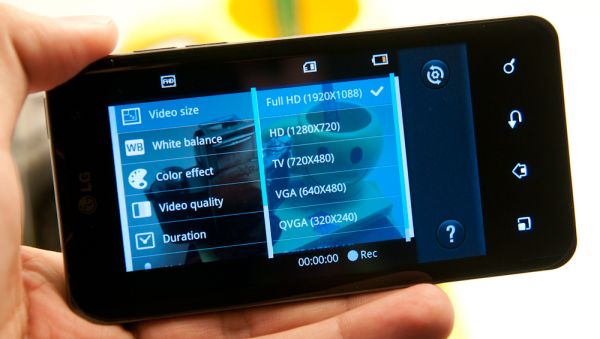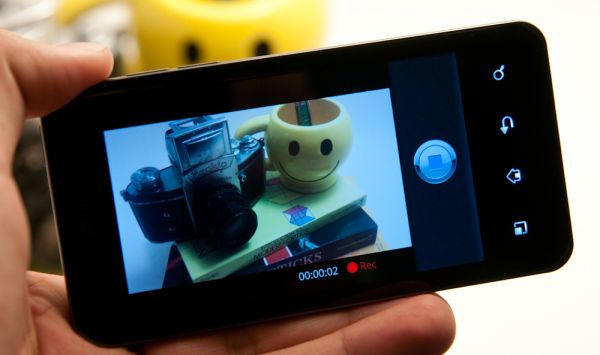LG Optimus 2X & NVIDIA Tegra 2 Review: The First Dual-Core Smartphone
by Brian Klug & Anand Lal Shimpi on February 7, 2011 3:53 AM EST- Posted in
- Smartphones
- Tegra 2
- LG
- Optimus 2X
- Mobile
- NVIDIA
Video Capture
The other big part of the 2X is that it’s the first smartphone to do H.264 1080P video capture. We took the 2X out to our usual test site and recorded video on the 2X at every quality setting at 1080p, and at maximum quality at 720P and VGA resolutions, and one final video with the front facing camera. I looked at the videos and then had Ganesh, our resident media center and video expert, as well as Anand take a look at the same original videos and compare to our other devices. It’s hard to argue that the iPhone 4 and Nokia N8 aren’t the devices to beat, both of them cranking out impressively sharp 720P video. We’ve done the usual thing and uploaded all the test videos to YouTube in addition to making a big zip for comparison in their original glory—links are in the table below.
Before we get to our comparison, a little background. First off, the 2X records 1920x1088 video in H.264 Baseline profile at an average of around 12 Mbps, audio is 1 channel AAC at 64 Kbps. The specifications for the 2x say 1080p24, in practice I’ve seen some framerate variability between 24 and 30 depending on lighting conditions. These videos are close to but not exactly 30 FPS, two videos I shot with the 2X at CES are clearly 24 FPS. Why the extra 8 pixels of vertical resolution, you might be wondering? The reason is simple—1088 is an even factor of 16, and macroblocks are 16x16 pixels.
| LG Optimus 2X Video Capture Samples | |||||
| Rear Facing 8 MP Camera |
1080P—SuperFine 1080P—Fine 1080P—Normal 720P—SuperFine 480P—SuperFine |
||||
| Front Facing 1.3 MP Camera | VGA—SuperFine | ||||
| LG Optimus 2X vs iPhone 4 at 720P | Mashup—YouTube, MP4 (zip), iPhone 720P (zip) | ||||
| LG Optimus 2X Original Videos | Original Videos (153.6 MB zip) | ||||
So how does 1080p24 video shot on the 2X compare to the iPhone 4 and Nokia N8? Unfortunately, not all that well. At 1080P there’s noticeable softness and loss of high spatial frequency detail. At about the 3 second mark in the first video I took (1080p at Super Fine) there’s also some noticeable glare from light flaring off of the glass surface between the camera’s last vertex and the plastic battery door. It’s that kind of stuff that’s a bit frustrating to still see going on with smartphones. The video has noticeable macro-blocking artifacts in the dark regions as well, which is disappointing. Though the Tegra 2 ISP is competent as shown by still image quality, clearly the video encode engine needs a bit more work. SuperFine as we already mentioned corresponds to around 12 Mbps, Fine corresponds to 8.5 Mbps, Normal quality seems to hover around 6 Mbps. You can fit a little over an hour of SuperFine quality 1080P video on the user-accessible 6 GB partition of the 2X’s 8 GB internal storage.
The obvious comparison really is at 720P, where we can directly compare the 2X’s video quality to the N8 and iPhone 4. I don’t have the N8 anymore, our comparison video is still what’s in bench. I do still have an iPhone 4, and captured a video taken at the exact same time as the 2X held carefully above the other phone. You can view both for yourself or compare with a mashup I put together showing both at the same time. The video I made showing both has a bit of downscaling and is at 30 FPS (so the 2X video occasionally looks like it’s dropping frames when it really isn’t), but still illustrates the differences.
Watching both at the same time, it’s readily apparent that the iPhone 4 does a noticeably better job with high frequency spatial detail, where the 2X seems to have softening. The 2X does do a better job with the dark areas of the intersection when panning back, but there’s still macroblocking visible. It’s obvious that there’s a combination of encoder and optics holding the 2X back from having dramatically higher quality video.












75 Comments
View All Comments
rpmrush - Monday, February 7, 2011 - link
Solid review, but please at least use spell check. I'm not a grammar or typo freak, but there were way too many simple typos that spell check wouldn't even let you get by with. At least have someone proof read it before you publish to the public.zowie - Tuesday, February 8, 2011 - link
who can create a new type battery, who will be the richest man in the worlduhuznaa - Tuesday, February 8, 2011 - link
Yeah, and until then those who manage to come up with some decent power management will be the richest...Seriously, every improvement on the battery front almost always just leads to devices drawing more power. It's somewhat ironic that last year's iPhone still leads the pack when it comes to battery life. Power management (that is: don't draw more power than absolutely necessary by throttling or shutting down components that aren't needed or aren't fully needed in a given moment) is hard and boring design work nobody seems to care for. And with devices and software getting replaced with the next iteration every few months this is even understandable, it's just not worth the effort, especially when nobody seems to care and benchmarks are so much more important to the crowd.
DanNeely - Tuesday, February 8, 2011 - link
How is is typically played back: Cropped, or vertically resampled?Wilco1 - Tuesday, February 8, 2011 - link
Tegra 3 has 4 1.5GHz Cortex-A9's according to a leaked slide.That was a great article! A few minor corrections: The ARM11 VFP is fully pipelined (so it can beat the A8 on FP performance). Like the A8, Scorpion is 2-way in-order, not limited out-of-order. In-order cores issue instructions in-order but may complete them out-of-order. On the other hand, OoO cores use register renaming to issue instructions out-of-order but complete them in-order.
Note none of the micro benchmarks used emits Neon instructions. JIT compilers don't have enough time to generate high quality code, let alone autovectorize! For proper benchmarking you will need to run native code compiled with a quality compiler (not GCC - it is still far behind the state of the art on ARM, especially Thumb-2).
metafor - Tuesday, February 8, 2011 - link
I would argue with that definition of OoO. A design does not need register renaming in order to issue any arbitrary instruction OoO. It's simply a trade-off of whether to centralize hazard tracking on register accesses or on retirement.PWRuser - Tuesday, February 8, 2011 - link
Excellent review. Please, in your future reviews don't stop including gems like this one:"Generally while browsing I can feel when Flash ads are really slowing a page down - the 2X almost never felt that way."
That's what matters! Including hands on observations along with a full volley of synthetic benchmarks.
This review comes as close as humanly possible to portraying a handset's ability to readers without the said readers trying it out.
Your attention to detail puts other reviews to shame. Keep up the good work.
sarge78 - Tuesday, February 8, 2011 - link
Don't forget about ST-Ericsson's U8500 A9. They could be a major player in 2011/2012 with potential design wins from Nokia and Sony Ericsson.warisz00r - Tuesday, February 8, 2011 - link
What equipments do you use to test the phone's audio quality with?phut- - Tuesday, February 8, 2011 - link
"NVIDIA tells us that the Tegra 2 SoC is fully capable of a faster capture rate for stills and that LG simply chose 2MP as its burst mode resolution. For comparison, other phones with burst modes capture at either 1 MP or VGA. That said, unfortunately for NVIDIA, a significant technological advantage is almost meaningless if no one takes advantage of it. It'll be interesting to see if the other Tegra 2 phones coming will enable full resolution burst capture. unfortunately for NVIDIA, a significant technological advantage is almost meaningless if no one takes advantage of it. It'll be interesting to see if the other Tegra 2 phones coming will enable full resolution burst capture. meaningless if no one takes advantage of it. It'll be interesting to see if the other Tegra 2 phones coming will enable full resolution burst capture."LG have probably made this decision based on the sensitivity of the invariably minuscule sensor they will have used. Having 6 frames of 12mp is pointless if they are 12 incomprehensible megapixels due to the lacklustre sensitivity of the pixels in their chosen part.
The kind of sensor you find delivering a meaningful burst in something like a 5D mk2 is enormous and power hungry, in comparison to an operating environment such as a phone.